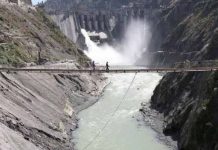Prime Minister Imran Khan believes that the functioning of the Diamer-Bhasha dam will not have any adverse effects on the climatic conditions of Pakistan.
“We won’t have to import fuel for this project nor will its construction affect our climate,” the PM said while addressing a public gathering in Chilas, Gilgit-Baltistan, after visiting the site of the Diamer-Bhasha dam.
The PM was accompanied by Federal Water and Power Minister Faisal Vawda, Army Chief General Qamar Javed Bajwa and ISI DG Lieutenant General Faiz Hameed.
The government aims to build the dam near the Nanga Parbat peak. It will stand 272 metres above the Indus River, being one of the highest dams in the world, if made.
Former chief justice Mian Saqib Nisar was one of the prominent personalities to have highlighted the importance of the dam. He and PM Khan found it the sole solution to the country’s water scarcity issue.
The premier believes that the destiny of the people of Gilgit-Baltistan will change for the better once the dam begins creating job opportunities for them.
He said the project will not add to the global warming problems of Pakistan, but environmentalists believe otherwise.
Speaking to The Third Pole, Gilgit-Baltistan Environmental Protection Agency Director Shehzad Shigri said the creation of the reservoir will have a devastating impact on the climate in the region.
“Around 0.1 billion cubic metres of water will evaporate every year from the reservoir [if the dam is constructed]. This may change the climate and weather patterns in the region,” Shigri said.
He believes the dam will divide communities on both sides of the Indus River and displace 50,000 residents.
Aisha Khan, the chief executive of the Civil Society Collation for Climate Change, also holds a similar views about the dam.
She feels that rising temperatures will accelerate the melting of Himalayan glaciers and a significant amount of water will be drained in the next 30 years.
The expert said the solution doesn’t lie in new dams, but in improved water management and cropping patterns.

















